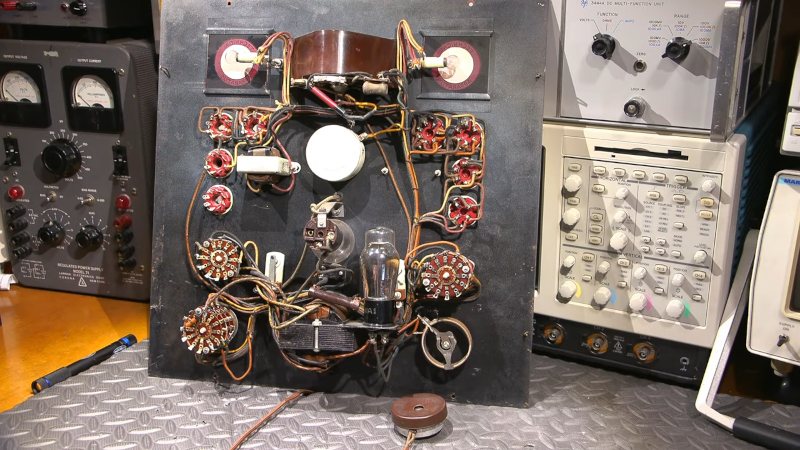[Mr. Carlson] has an old-style 1940-era radio tube tester, the kind that used to inhabit grocery and drug stores. It is in amazing condition and he was kind enough to tear it down for us. The tester is a Model X from the Radiotechnic Laboratory in Evanston Illinois and, like [Mr. Carlson], we were amused that one of the indicators on the device is a Ouija board-like “doubtful” reading. When it lights up, it looks amazing.
This is much older than the old “TV tube testers” we remember as a kid, but the idea is the same: you have a bad radio or TV with tubes in it, it is a fair bet that the problem is a tube. Even if you don’t know much about electronics, you can carefully remove the tubes, drive over to the drugstore, test your tubes and buy a replacement for any that are bad. Uniquely, this tester even had a speaker you could use to listen to the tube’s output while testing.
We miss the old wafer-style rotary switches. There isn’t much inside, but we were surprised to see one of the test sockets had absolutely no wires connected to it. Inside there is a vacuum tube rectifier which leads to the question of what happens to the tube tester if it, itself, has a bad tube.
We wonder if you could put this much high voltage next to consumers today. Probably not. But it was great to get a look inside a very old version of this once common device.
We saw a 1958 tester that used punch cards. If you have enough gear laying around, you don’t even need a dedicated tube tester.

















I don’t miss wafer switches.
Easily oxidized.
The “Airline” logo on the tester,
Wards Airline?
But, they are waafer theen!
Oh, all right, p’raps just one ..
Also easy to clean with deoxit. Though what that stuff does to the ol liver I’d rather not contemplate.
Booze counteracts it.
Monkey Wards finest. Bare bones. Emission? Mutual conductance, rather not. Gas?
It helped sell tubes.
I remember those. As a kid, I maintained my relatives’ TVs. An uncle had left behind a TV repair manual, too.
I still have a tube tester, built from an Eico kit. Don’t have much use for it now.
And for years, I had a Zenith “portable” TV that an aunt gave up trying to get fixed. Turned out the problem was a bad tube SOCKET. The filament ground had no lug; it was mechanically connected to the metal chassis. I’d watch TV all night one day, and the next, it would not work. Finally noticed the tube would not always glow, and found the problem. Wrapped wire around the pin contact, soldered it, and soldered it to a convenient ground. Worked for years.
The drug store tube testers I remember didn’t trust the customer to set switches according to a book. Instead, they had upwards of a hundred tube sockets, and just had a chart that told you which socket to plug the tube into, and then two pushbutton switches to test two different parameters.
In the 70’s we had secondhand TVs for most of the decade. Having a 25″ color console TV with dual speakers and tambour sliding doors to cover the screen when not in use was hot stuff, even if it was a few years old.
I remember going to the Ernst hardware store with dad and a bag of tubes a few times to use their big tester. He’d plug them all in to see which was bad then pick out a replacement from the bins in the bottom of the tester cabinet.
IIRC we got our first new television circa 1979. A 19″ KMC from K-Mart. All Solid State said the badge on it. What prompted that purchase was the store with the tube tester had gotten rid of it and no longer sold tubes.
https://en.wikipedia.org/wiki/Ernst_Home_Centers
The empty socket was for straightening 9 or 12 pin mini tubes connector pins
Tube way electronics need a tubeway tester save your money buy a tube tester aka tubeway army
When I went nuts hoarding tubes-mostly preamp off of eBay etc. around the turn of the century, I would use my Fender VibroChamp with one 12AX7 slot* as a tube tester. If the amp worked with no bizarre howling the tube tested OK.
* Astute readers may note that a VC has two 12AX7 tubes. The second is for the Vibrato feature.